Still a brisk 33°F when we started birding in Santa Cruz Flats at 8:22 a.m., we were glad to be traveling in two cars rather than walking the roads. I was part of a Desert Rivers Audubon Field Trip of six birders to this area with Claudia Kirscher guiding.
If you live in either the Phoenix or Tucson area and travel between those two cities on I-10, at about the half-way point you pass right by the "Flats". In many years gone by, grasslands spread out over its 350 square miles where deer and antelope played. When cattle were introduced, the habitat changed dramatically so that our birding area is now desert scrub, some of which is farmed for cotton and vegetables (lettuce, broccoli) and turf (for anything from sporting fields to homes in the desert). Water is pumped in through canals and irrigation systems.
Our route into the Flats began from Sunshine Boulevard, to Phllips, then Barrett, then Nutt.
Along these roads were field after field of pecan trees, now devoid of leaves but full of pecans! Oh, do the birds like them!
Our excitement stirred when the first bird of the day was a rare-for-here, HARLAN'S RED-TAILED HAWK. It summers in Alaska and the Yukon, but winters east of us in the middle of the country -- very rare along the east coast and rare in the west unless is slips into Arizona during migration. Claudia knows her raptors and introduced this one to us as a returning HARLAN'S.
 |
| HARLAN'S RED-TAILED HAWK with blackish and whte plumage; note how it has one foot pulled up as if to keep it warm |
 |
| Oddly, the tail is white and in flight a dark band spreads along the tip of the tail. |
Have I ever seen a Harlan's RTHA before? Only when one has been pointed out to me, but I'm learning the details that will help me identify it in the future.
Our standard WESTERN RED-TAILED HAWK is a stocky bird with rounded wings and short, red tail of various hues. Looking up at the hawk from the ground, you see a light belly with a "belly band" (dark streak of feathers) and the front leading edge of the wings is always dark. It's brown head is distinctive as is the white speckled V on its back. Photos below are of our Western Red-tailed Hawk:
 |
| Standard RED-TAILED HAWK |
Today, we saw at least two RUFOUS-MORPH RED-TAILED HAWKS. Look at this one below!
 |
| RUFOUS MORPH RED-TAILED HAWK Note how different it is from both the Harlan's and the Western Red-tailed Hawk |
Both hawks were observed early as we started out in the pecan-tree area.
Later, we checked out Evergreen Turf Farm to search for MOUNTAIN PLOVER that favor that area. Seldom close to the road from which we must bird, the spotting scope located a few for us but they were beyond camera range. Photo below was taken a few years ago at the same location when the plovers were foraging closer to the roadway.
 |
| Another time, I was able to get a closer pic of the MOUNTAIN PLOVER |
A BARN OWL was an unexpected find in an old building on the scrub land.
LOGGERHEAD SHRIKEs are handsome, solitary and always perch up and out in the open. Maybe that's why I like it so much!! No hiding behind big leaves for this hunter. Coloration is similar to Northern Mockingbird, but the shrike is smaller and more distinct. Its bill is short and hooked; it's a predator. And, if plenty of food is available, it keeps hunting and impails its grasshoppers or other insects on a barbed wire fence for later munching.
 |
| LOGGERHEAD SHRIKE |
Since it was distant, photos were poor. I post only one from today; the others are from previous visits to the Flats.
 |
| Heat-wave distortion this afternoon |
 |
| Two CRESTED CARACARA |
 |
| CRESTED CARACARA |
What a sight! A murmuration of YELLOW-HEADED BLACKBIRDs overhead! [murmuration is a large group of birds flying in syncopated symmetry] The flock numbered in the hundreds. In great numbers, the YHBL flew up and out from the feed lot, into the air and waltzed as one, looping through the sky. At about the same time another very large murmuration flew overhead and smoothly replaced the birds that had flown up and away.
Cows are free to walk around the grounds beyond the covered feeding areas, so there is a rank sensation to this sort of birding. But the reward was sensational.
 |
| Female (L) and Male (R) YELLOW-HEADED BLACKBIRD |
We came up with a low count of 8,000 YELLOW-HEADED BLACKBIRDs at the feed lot.
 |
| YHBL were packed in with the cows |
What a finale!
After 7.5 hours, driving 71 miles throughout the large area of SANTA CRUZ FLATS, each of us (Gwen Grace, Laura Royal, Scott Brockenbrough, Hinde Silver, Babs Buck (me) and our leader Claudia, were smiling broadly, deeply.
Til next time...
* * *
View this checklist online at http://ebird.org/ebird/view/checklist/S42144813
View this checklist online at http://ebird.org/ebird/view/checklist/S42145001
View this checklist online at http://ebird.org/ebird/view/checklist/S42145153











No comments:
Post a Comment